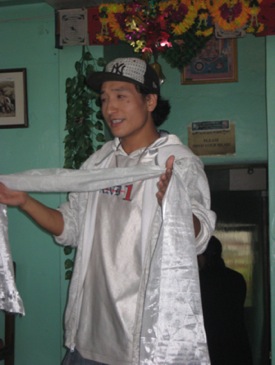Tibetan Symbols - Khata
by Gloria
(United States)
Dear Patricia,
I am very happy to have found your website! I also think the Tibetan people and their culture are beautiful! And well deserving of all the help I can give.
I have been lucky enough to meet a few Tibetans and to meet monks from the Drepung Gomang Monastery. I do not have the means or the courage to go to Dharamsala. However
I am happy to say there are many resources near me that I can use to Help.
I do have a question if you please.
Is it proper to give a Khata to a visiting Geshe?
We have 10 monks and their Geshe coming from the Drepung Gomang in May and I want to behave with proper Tibetan etiquette.
Any help you can give me will be greatly appreciated .
Tashi Delek Gloria
Dear Gloria,
Yes, it is proper Tibetan etiquette to offer a khata (white offering scarf) to any visiting teacher or Lama when they arrive or when you go to visit them. Khatas are offered in long life ceremonies of teachers and wrapped around all the presents and offerings that are given.
The khata can be presented at any festive occasions to a host or at, births, graduations, funerals, arrivals and departure of guests etc. You can say "Tashi Delek" (good luck) when you offer it to someone.
At weddings, a khata is offered to the bride, groom and each of their family members. Tibetan songs are traditional sung and a khata is held while singing like in one of the wedding pictures above. Sometimes the khata is wrapped around the neck of a whisky bottle and held!
The Dalai Lama is known to offer a Khata as a gift to diplomats, visitors, or other monks, which symbolizes purity of intention and the beginning of a relationship.
It symbolizes goodwill and auspiciousness. It is usually white symbolizing the pure heart of the giver but you can also find yellow or blue scarves as well.
Some khatas are decorated with the eight auspicious symbols.
When a thangka or a Tibetan deity painting is mounted on a wall it is always offered a khata which is drapped over the top of it. Katas are also offered to Buddhist Statues or to the throne or seat of teachers.
I hope this answers your question!
All the best,
Patricia from Tibetan Life


